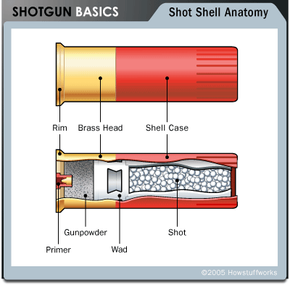Types of Ammo: Shot
Cartridges filled with shot are the most common type of shotgun ammo. Shot are little balls made of any number of metals, including lead, steel, bismuth, tin and zinc.
Each metal behaves a little differently. Lead has some properties that make it one of the most effective materials for shooting game and targets. It is relatively heavy and therefore maintains its explosive force well. It is also somewhat soft, so it changes its shape as it leaves the barrel. This gives it a more spread-out shot pattern than other materials but still delivers a great deal of energy. There is some evidence that because steel pellets do not deform -- they maintain their round shape throughout their flight -- they wound animals without killing them more often than lead.
Advertisement
Until the early 1990s, most shot was made of lead. As environmentalists studied its effect on the ecosphere, they found that the spent lead shot hunters left in waterways and forests had harmful effects on wildlife and risked contamination of drinking water. Lead shot has been banned from waterfowl hunting in the United States since 1992, and various types of steel and alloy shot have taken its place.
The rule of thumb for shot size is the higher the number, the smaller the diameter of the shot. There is a consistent standard in the United States, but worldwide the numbers don't correspond to any specific measurement across the board. At Chuck Hawks' Shot Pellet Information and Recommendations, you'll find a guide to the various sizes in the United States and what they are used for. In hunting, smaller ammo is used for smaller game, and larger ammo is used for larger game. Buckshot is large-sized shot that got its name because it is used to hunt deer. Because different materials have different weights and characteristics, shot size alone does not tell the whole story. For example, if you are shooting with steel, you'd have to use larger shot than you would if you were doing the same type of hunting with lead.
